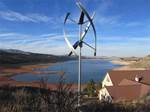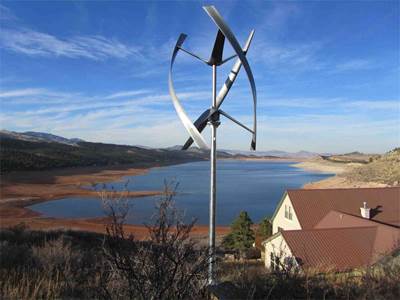HAWTs vs. VAWTs
Horizontal-axis wind turbines (HAWTs) command the small wind turbine (SWT) market, led by a handful of companies that have been in production for 20 to 30 years, while vertical-axis wind turbine (VAWT) manufacturers, with the exception of Ropatec (Bolzano, Italy), have mostly developed within the past five years.
Horizontal-axis wind turbines (HAWTs) command the small wind turbine (SWT) market, led by a handful of companies that have been in production for 20 to 30 years, while vertical-axis wind turbine (VAWT) manufacturers, with the exception of Ropatec (Bolzano, Italy), have mostly developed within the past five years. VAWTs have posted high growth and proliferated quickly, but according to Getting real about small wind, published in February 2010 at renewableenergyfocus.com by turbine manufacturer Ampair’s managing director David Sharman, they nevertheless account for only 2 to 3 percent of overall units.
HAWTs overwhelmingly use three blades, though there are several models with two or five blades. By contrast, VAWT configurations and blade shapes vary quite a bit, but most feature two, three or five vertical blades. The majority of VAWTs are some form of Savonius (drag-type) or Darrieus (lift-type) configuration, or a combination of the two (see Editor's Note, below).
VAWTs have several advantages. They are omnidirectional, that is, they do not change orientation to match the wind direction as HAWTs must do. This reduces the number of parts. Almost all VAWTs feature a direct drive (they require no gearbox between the rotor and the generator). This significantly reduces operating costs while increasing durability and reliability. VAWTs are reportedly much more efficient in turbulence, enabling rooftop and urban installations, and they turn at comparatively lower revolutions per minute, thus producing less vibration and noise. Most VAWT manufacturers quote noise levels of less than 40 dB at a distance of less than 20 ft/6m, while the few HAWT builders that offer such measurements often report 50 to 60 dB or more at much greater distances. VAWTs are typically more compact and operate at lower elevations, making them less visually intrusive.
However, VAWTs might have issues, some say, with reliable self-start in low wind speeds and also with less efficient power production than HAWTs (the low rotation speeds are quiet but not necessarily efficient). This issue is discussed in a paper by Jacken Chen, founder and general manager of Hi-VAWT Technology Corp., a Taiwan-based manufacturer of a combined Savonius/Darrieus VAWT. The Savonius unit provides a more reliable self-start, but the Darrieus components provide efficient power. Meanwhile, other sources claim that simply modifying Darrieus designs via optimal turbine sizing and higher-performance blade shapes will do the same.
That aside, skeptics argue that the poor quality of wind at lower heights and in urban/suburban settings is a technical barrier that VAWTs will never overcome. Small wind commentator Mike Sagrillo cites two examples in his experience: a 6-kW vertical turbine that, when installed on a government building for $51,000, produced only 400 kW-hr in 10 months (the payback was calculated as 890 years) and a $40,000 VAWT that generated only 41 kW-hr in seven months (with a payback of 4,761 years).
And yet, according to Ropatec project manager Alessandro Bortolotti, the real issue is proper planning and siting. His company has installed roughly 1,000 VAWTs, and in Bortolotti’s experience, “the main problem is that people think you can put a turbine on a building and automatically you will have more wind, but that is not true.” He explains that “it is necessary to measure wind speed and direction for at least 6 months on a 6m [20-ft] pole.” Having completed many rooftop installations, Ropatec advises, “The turbine must also be situated in the main wind direction and be mounted on a mast at least 6m in height to avoid turbulence created by the building itself.”
Nick Sassow, COO of recent VAWT startup SEaB Energy Ltd. (Southampton, U.K.), points out that the total cost to be considered in calculating payback is not just unit purchase and installation, but it also includes cost of maintenance and downtime for repairs. HAWTs have a higher number of service points, including pitch and yaw controls and bearings, and access becomes increasingly time- and cost-intensive with installation height. Also, for some turbines and maintenance problems, a technician may be required at a not trivial hourly rate. Thus, downtime and maintenance costs can significantly alter the total time in operation, output and payback.
The issue of overly optimistic claims and the need for an apples-to-apples comparison of small wind turbine performance, safety and durability are being tackled in the U.S. by the Small Wind Certification Council (SWCC, Clifton Park, N.Y.), which began to accept applications in 2010. Twenty-five products from 21 companies are currently in the certification process. Six of these are VAWTs. Further, the U.K.’s Microgeneration Certification Scheme (MCS) was enacted last year to reach these same goals and also determine eligibility for feed-in tariff (FIT) compensation. MCS certifies that both SWT manufacturers and installers meet the requirements for small turbines as defined in the international standard for small wind turbines, IEC 64100 Part 2. Meanwhile, Beijing, China-based ATKEPP Consulting Ltd. is working with the China Certification and Accreditation Institute to develop an SWT standard and certification scheme for China.
Editor's Note: Savonius and Darrieus turbine types are described, respectively, at http://en.wikipedia.org/wiki/Savonius_wind_turbine and http://en.wikipedia.org/wiki/Darrieus_wind_turbine.
Related Content
Materials & Processes: Fabrication methods
There are numerous methods for fabricating composite components. Selection of a method for a particular part, therefore, will depend on the materials, the part design and end-use or application. Here's a guide to selection.
Read MoreCarbon fiber in pressure vessels for hydrogen
The emerging H2 economy drives tank development for aircraft, ships and gas transport.
Read MoreMaterials & Processes: Fibers for composites
The structural properties of composite materials are derived primarily from the fiber reinforcement. Fiber types, their manufacture, their uses and the end-market applications in which they find most use are described.
Read MorePlant tour: ÉireComposites, Galway, Ireland
An in-house testing business and R&D focus has led to innovative materials use and projects in a range of markets, from civil aerospace to renewable energy to marine.
Read MoreRead Next
Small wind gets big
Massive growth, complex blade designs reopen challenging market in wind energy niche.
Read MoreFrom the CW Archives: The tale of the thermoplastic cryotank
In 2006, guest columnist Bob Hartunian related the story of his efforts two decades prior, while at McDonnell Douglas, to develop a thermoplastic composite crytank for hydrogen storage. He learned a lot of lessons.
Read MoreCW’s 2024 Top Shops survey offers new approach to benchmarking
Respondents that complete the survey by April 30, 2024, have the chance to be recognized as an honoree.
Read More








.jpg;maxWidth=300;quality=90)

















